
* The delta-winged Dassault "Mirage III" fighter was one of Europe's first operational supersonic combat aircraft, and proved popular in French and export service. Their success led Dassault to produce a next-generation fighter, the "Mirage 2000", with a similar configuration, though it was in fact an entirely new and much more capable design. It would prove successful as well. This document provides a history and description of the Mirage 2000 series fighters -- as well as of the one-off "Mirage 4000" heavy fighter.

* The Mirage 2000 evolved from a series of Dassault design efforts performed from 1965 to 1975. The first in this series was a collaborative project known as the "Anglo-French Variable Geometry (AFVG)" swing-wing aircraft, begun in 1965. The collaboration was a fiasco, with the French pulling out in 1967. The British stayed with the concept and formed another collaboration with the Germans and Italians, which eventually produced the Panavia Tornado multi-role combat aircraft.
Dassault then worked on several new aircraft concepts evolved from their "Mirage G" variable-geometry experimental prototype, resulting in a sophisticated design with the designation "Avion de Combat Futur (ACF / Future Combat Aircraft)". The ACF prototype was almost complete when the French government canceled it in December 1975; the ACF was simply too big and expensive. However, Dassault had been considering other fighter options in the meantime, partly because the export potential of the ACF was unpromising.
These alternatives were smaller, simpler, and cheaper than the ACF, and took the form of a number of "Mini-Mirage (MiMi)" concepts developed beginning in 1972 on a "back-burner" basis. These concepts congealed into an aircraft known at first as the "Super Mirage III", then the "Delta 1000", "Delta 2000", "Super Mirage 2000", and finally just "Mirage 2000". When the ACF was canceled, Dassault was able to immediately offer the Mirage 2000 as an alternative, and the French Defense Council accepted it. It wasn't exactly an even trade, since the ACF was a strike aircraft first and an interceptor second, while the Mirage 2000 was exactly the reverse -- but the Mirage 2000 was much more affordable.
There was another reason for Dassault to push the Mirage 2000. In 1975, four European nations selected the General Dynamics F-16 as their new first-line fighter, rejecting an improved Mirage F1. Marcel Dassault was disgusted with the choice, feeling his company could build a better aircraft and find success with it on the export market.
The new and powerful SNECMA M53 afterburning low-bypass turbofan engine, which had been developed for the ACF, was available for the Mirage 2000, but radar development threatened to be a critical path. Despite such obstacles, Marcel Dassault felt that a prototype could be flying in a year and a half, with operational introduction in 1982. In fact, the program was delayed. Initial flight of the first prototype was on 10 March 1978, with Jean Coreau at the controls. The first production example flew on 20 November 1982, and operational service was finally attained in 1984. However, by the standards of modern defense programs that was not all that big a schedule slip.

* Retaining the delta wing configuration seemed to many like a backward step. Dassault had used that configuration on the Mirage III, but abandoned it for the Mirage F1. A delta wing tends to be a good choice in terms of high-speed flight characteristics, simplicity of aircraft construction, relatively low radar signature, and internal volume. It tends to be a poor choice in terms of maneuverability, low-altitude flight, and length of take-off and landing run.
Dassault engineers managed to bring the delta wing up to date by moving the aircraft's center of lift to the front of its center of gravity, giving the fighter a degree of instability that enhanced maneuverability. That also reduced the take-off run: in the older Mirage deltas, lowering the elevons on take-off to increase lift would push the aircraft's nose back down, but shifting the center of lift eliminated this problem.
A runway arresting hook or fairing for a brake parachute could be fitted under the tail, though that position was more generally fitted with a Dassault Eclair manually-operated chaff-flare dispenser. The landing roll was reduced by robust carbon brakes. The backward retracting steerable nose gear featured dual wheels, while the main gear featured single wheels and retracted inward into the wings.
The aircraft featured a redundant "fly-by-wire automatic flight control system (FBW AFCS)", providing electronic "smarts" to compensate for the aircraft's inherent instability; two-piece elevons on each wing; and automatic, full length, two-segment leading-edge slats. That gave the Mirage 2000 a level of agility that the Mirage III and 5 lacked, and in fact the new machine would acquire a reputation for superb handling. An airbrake was fitted on top of each wing, the arrangement being very similar to that of the Mirage III. A noticeably taller tailfin allowed the pilot to retain control at higher angles of attack, assisted by small strakes mounted along each air intake.
Most of the aircraft was made of aircraft aluminum alloy, but some titanium and carbon fiber composite parts were used as well. Built-in armament consisted of twin DEFA 554 (now GIAT 30-550 F4) 30-millimeter revolver-type cannon with 125 rounds each. The cannon had selectable fire rates of 1,200 or 1,800 rounds per minute. The Mirage 2000 could carry up to 6.3 tonnes (13,900 pounds) of stores on nine pylons, with two pylons on each wing and five under the fuselage. The centerline pylon and one pylon under each wing were "wet", able to carry external fuel tanks. A fixed removeable refueling probe could be attached in front of the cockpit, offset to the right. The pilot sat on an SEMB Mark 10 zero-zero ejection seat, a license-built version of the British Martin-Baker Mark 10.
BACK_TO_TOP* The first Mirage 2000 to go into service was the single-seat "Mirage 2000C" interceptor / air combat variant. There were four single-seat prototypes, including the first Mirage 2000 prototype mentioned above. The first production Mirage 2000C flew in November 1982. Initial deliveries were in 1983. The first operational squadron was formed in 1984, the 50th anniversary of the French Armee de l'Air (AA).
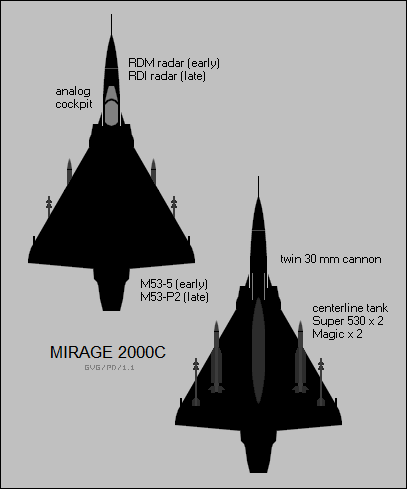
As it was originally delivered, the Mirage 2000C was powered by a SNECMA M53-5 engine with 54.0 kN (5,500 kgp / 12,230 lbf) dry thrust and 86.3 kN (8,800 kgp / 19,400 lbf) afterburning thrust, and was fitted with the Thomson-CSF (now Thales) "Radar Doppler Multifunction (RDM)". Other standard avionics included a Sagem ULISS 52 inertial navigation system (INS), a central processor and an air data computer, TACAN beacon navigation system, ILS landing system, and radios. The defensive avionics fit included:
The cockpit layout featured mostly traditional analog instrumentation, though there was a head-down radar display and a head-up display (HUD).
Primary armaments of the Mirage 2000C in the interceptor role were the Matra Super 530 medium-range semi-active radar-guided air-to-air missile (AAM) on the inboard wing pylons, and the Matra Magic short-range infrared-seeking AAM on the outboard wing pylons. The Mirage 2000C could also carry air-to-ground stores, such as iron bombs, cluster bombs, or Matra 68-millimeter rocket pods, in its secondary strike role. It had no smart munitions capability, though it could carry laser-guided bombs (LGBs) if another aircraft or ground forces provide designation. Standard colors consisted of light gray on the bottom and a disruptive pattern of light gray and gray blue on top.
___________________________________________________________________
DASSAULT MIRAGE 2000C:
___________________________________________________________________
wingspan:
9.13 meters (29 feet 11.5 inches)
wing area:
41 sq_meters (441.3 sq_feet)
length:
14.36 meters (47 feet 1.25 inches)
height:
5.20 meters (17 feet)
empty weight:
7,500 kilograms (16,500 pounds)
max loaded weight:
17,000 kilograms (37,500 pounds)
maximum speed:
2,340 KPH (1,450 MPH / 1,260 KT)
service ceiling:
18,000 meters (59,000 feet)
range:
1,480 KM (920 MI / 800 NMI)
___________________________________________________________________
A total of 124 Mirage 2000Cs was obtained by the AA. AA pilots were delighted with the "Deux-Mille", regarding it as a marvelous aircraft to fly, with high performance, light and crisp control response, and an "eye watering" roll rate. Improvements were added to the Mirage 2000 in production and through field upgrades:
Armament was substantially improved by the new Matra MICA AAM, which became the AA's standard AAM -- MICA standing for "Missile d'Interception, de Combat et d'Autodefense / Intercept, Combat, & Self-Defense Missile". It was a lightweight and highly agile weapon, with a thrust-vectoring nozzle. There were two versions, including the heatseeking "MICA IR" and the radar-guided "MICA EM". The infrared seeker on the MICA IR could in principle provide video to the cockpit to act as an infrared search & track sensor. The radar-guided MICA EM variant provided a "fire & forget" capability. However, the Mirage 2000C only carried the MICA IR, there being no support for the MICA EM in the aircraft's weapons control system.
* While the first four Mirage 2000 prototypes were all single-seat aircraft, there was a fifth, company-funded prototype of a tandem two-seat operational conversion trainer variant, the "Mirage 2000B", which performed its initial flight on 11 October 1980 with Michel Porta at the controls.
As it emerged, the Mirage 2000B was very similar to the Mirage 2000C except for the two-seat configuration, with similar avionics kit and combat capability. The Mirage 2000B did not have a built-in cannon -- no Mirage 2000 two-seater ever would -- but it could carry the CC630 pod with twin 30-millimeter cannon and 300 rounds per gun. The ADA acquired 30 Mirage 2000Bs, with all three of the AA fighter wings obtaining a few Mirage 2000Bs for conversion training.
* French Mirage 2000s saw operational use during the First Gulf War in 1991, though apparently they did not see much actual combat action. French Mirage 2000s were prominent participants in UN and NATO air operations over the former Yugoslavia, with one aircraft shot down over Bosnia by a heat-seeking surface-to-air missile in 1996, prompting efforts to obtain improved defensive systems.
BACK_TO_TOP* "Mirage 2000E" was a blanket designation for a series of export variants of the Mirage 2000, with the aircraft actually having a wide range of different designations, depending on the customer nation. These aircraft were fitted the M53-P2 engine and an enhanced "RDM+" radar, and all could carry the day-only ATLIS II laser targeting pod -- though not all customers acquired the pod.
* Egypt was the first buyer, ordering 16 "Mirage 2000M" fighters and four "Mirage 2000BM" trainers in late 1981, with deliveries beginning in 1986. The Egyptians also purchased ATLIS II pods and a wide range of appropriate munitions for their shiny new Mirages, including Magic and Super 530 AAMs, AS-30L laser-guided air-to-surface missiles (ASMs), and Armat anti-radiation missiles (ARMs).
* India became a big user of the Mirage 2000. The order history is a bit complicated:
The total came to 49 IAF Mirage 2000s, including 42 single-seaters and 7 two-seaters. In 2004, the Indian government approved purchase of ten more Mirage 2000Hs, with these machines featuring improved avionics, particularly an upgraded RDM 7 radar.
The IAF named the Mirage the "Vajra", loosely translated as "Thunderbolt". India also purchased appropriate stores along with the fighters, including ATLIS II pods and laser-guided weapons. There were unverified reports that the IAF qualified Soviet-designed munitions with the Mirage 2000, such as the R-27 (NATO AA-11 Alamo) AAM. It is also rumored that India assigned the nuclear strike role to their Mirage 2000s. They were used in 1998 during a major border clash with the Pakistanis in the mountains near Kashmir, dropping LGBs to good effect.
A contract was signed in 2011 to upgrade all IAF Mirage 2000H machines to the Mirage 2000-5 Mark 2 spec, discussed later; India also went on to obtain the MICA IR AAM. The first of the 48 aircraft to be updated was returned to the IAF in 2015, with the first two upgrades implemented in France and the rest by Hindustan Aeronautics in India. The program stretched out, and hasn't been completed at last notice. In 2021, India obtained 24 phased-out AA Mirage 2000s, primarily for use as spares hulks.
* Peru placed an order that, after some complications, amounted to ten "Mirage 2000P" fighters and two "Mirage 2000DP" trainers. The Peruvians ordered a set of munitions similar to that ordered by Egypt, along with ATLIS II targeting pods. The Peruvian Mirage 2000s saw limited action in a border clash with Ecuador in 1995. From 2009, they were given a minor avionics update.
* This first series of Mirage 2000Es sold to Egypt, India, and Peru were followed by a second series featuring modest avionics enhancements that was sold to Abu Dhabi of the UAE, and Greece.
Beginning in 1983, Abu Dhabi / UAE purchased 22 "Mirage 2000EAD" fighters; 8 unique single-seat reconnaissance variants designated the "Mirage 2000RAD"; and 6 "Mirage 2000DAD" trainers, for a total order of 36 machines. The order specified an Italian-made defensive avionics suite that delayed delivery of the first of these aircraft until 1989. Abu Dhabi Mirages also flew in the First Gulf War, but saw little or no action.
The "Mirage 2000RAD" reconnaissance variant did not have any built-in cameras or sensors, and the aircraft could still be operated in air combat or strike roles. The reconnaissance systems were implemented in pods, including the Thales / Raphael "SLAR 2000" radar pod; the Dassault "COR2" multi-camera pod with visible and infrared imaging capability; and the Dassault "AA-3-38 HAROLD" telescopic long-range optical camera pod. Abu Dhabi was the only nation to obtain such a "specialized" reconnaissance variant of the Mirage 2000.
* Beginning in March 1985, the Greeks ordered 36 "Mirage 2000EG" fighters and 4 "Mirage 2000BG" two-seat trainers. They featured an "ICMS 1" defensive countermeasures suite, which was an updated version of the standard Mirage 2000C countermeasures suite, characterized by two small antennas near the top of the tailfin. These Mirage 2000s were later modified in the field to carry the Aerospatiale AM39 Exocet anti-ship missile.
BACK_TO_TOP* Since the Mirage 2000 was proposed to the French government as an alternative to the ACF, which was a strategic strike aircraft, of course there was interest in developing a dedicated strategic strike variant. This variant was intended to carry the Aerospatiale "Air-Sol Moyenne Portee (ASMP)" nuclear stand-off missile, development of which began in 1978.
The nuclear strike requirement materialized into an order in 1979 for twin prototypes of a two-seat Mirage 2000 variant for this purpose, with a navigator / weapons system operator (WSO) occupying the back seat. The type was originally designated "Mirage 2000P", for "Penetration", but the designation was then changed to "Mirage 2000N", for "Nucleaire". Initial flight of the first of two prototypes, both new-build machines, was on 3 February 1983 with Michel Porta at the controls. The first flight of a production aircraft was in March 1986, and the type entered operational service in 1988. 75 were built.
As it emerged, the Mirage 2000N was derived from and externally similar to the Mirage 2000B, with the M53-P2 engine, but the nuclear strike variant featured strengthened wings for low altitude operation, as well as a low-level precision navigation-attack system built around the Dassault / Thales "Antilope 5" radar, designed for the strike role and with terrain-avoidance capability. Cockpit layout was analog, along the lines of that of the Mirage 2000B. The cockpit was night vision goggle (NVG) compatible. The Mirage 2000N also retained ULISS 52 INS, SERVAL RWR, and Spirale dispensers (early production had the Eclair dispenser instead). However, the SABRE jammer was replaced by the improved Chameleon jammer.
Since the Mirage 2000N's standard weapon was the ASMP, which was carried on the centerline pylon, that meant it couldn't carry a centerline tank, but a distinctive big 2,000-liter (530 US gallon) underwing drop tank with a bulbous nose was developed to more than compensate.
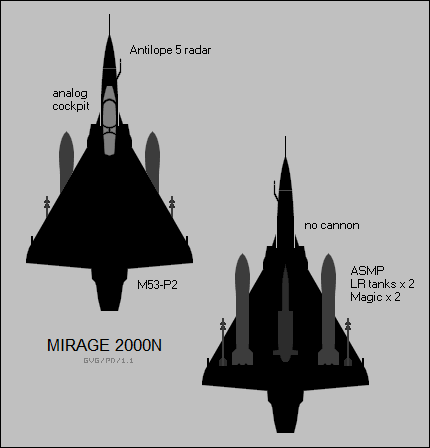
The ASMP missile was 5.38 meters (17 feet 8 inches) long and was powered by a ramjet, which allowed it to cruise at Mach 3 after being brought up to speed by a solid-propellant booster. The weapon carried a 150 or 300-kiloton warhead, and could follow terrain using a pre-programmed inertial navigation system to hit a target up to 100 kilometers (62 miles) away.
The Mirage 2000N carried a single ASMP and could carry Matra Magic AAMs for self-defense, later carrying MICA IR AAMs for that purpose. The first 31 built could not carry other stores and were designated "Mirage 2000NK1", but following machines could also carry conventional air-to-ground munitions and were designated "Mirage 2000NK2". They carried dumb munitions, such as:
Like the Mirage 2000C, the Mirage 2000N-K2 could carry LGBs, but they had to be spotted by another aircraft or by ground forces. The AA reserved the Mirage 2000N for the nuclear strike role and was not eager to assign it other missions. An improved defensive countermeasures system was fitted from 2000, including:
Retirement of various air assets forced the AA to relax the "nuclear only" policy on the Mirage 2000N, and the type was modified for the tactical reconnaissance role, carrying the Thales "Pod de Reconnaissance Nouvelle Generation / Pod Reco NG / New Generation Reconnaissance Pod". The Pod Reco NG provided digital reconnaissance capabilities, with both day and night imagers; a digital data recorder system; and a datalink to provide real-time relay of imagery to battlefield commanders.
From 2009, 30 Mirage 2000Ns were updated to carry the new "ASMP-A" cruise missile, with greater range and accuracy than the ASMP. Aircraft with the updated countermeasures system and capable of carrying both the ASMPA missile and the Pod Reco NG were redesignated "Mirage 2000K3". The Mirage 2000N was finally retired from service in 2000, the nuclear strike role having been taken up by the Rafale -- which also took over the air-superiority role from the Mirage 2000C. The last AA Mirage 2000C was retired in 2022.
BACK_TO_TOP* Delays in the Rafale fighter program led to an AA announcement in 1986 of a development program for an updated Mirage 2000N dedicated to conventional attack, originally designated the "Mirage 2000N Prime". It was to complement AA SEPECAT Jaguar daylight strike fighters by providing a night / bad weather attack capability.
Formal development began in 1988. The designation was changed to "Mirage 2000D" in 1990, with the "D" standing for "Diversifie / Multi-role". Initial flight of the Mirage 2000D prototype, a modified Mirage 2000N prototype, was on 19 February 1991. That led to first flight of a production aircraft on 31 March 1993, and introduction to service in April 1995. 86 were built in all to last delivery in 2001.
As it emerged, the Mirage 2000D featured:
One distinguishing feature of the Mirage 2000D was that it did not have a nose pitot probe. Early machines were delivered with limited offensive stores capability and were upgraded as more stores were qualified. Full-specification "Mirage 2000D-R1" aircraft could carry stores such as:
The Mirage 2000D remains in service with the Armee de l'Air et de l'Espace (AAE) -- the French Air & Space Force, as the service was redefined in 2020. A general upgrade designated the "Mirage 2000D-R2" machine was delivered from 2001. It featured an enhanced countermeasures suite, noticeably featuring twin 24-shot flare dispensers on each side of the spine at the front of the tailfin. The Mirage 2000D was also qualified for improved stores, including the:
A second upgrade program was begun in 2009, but stalled -- to be revived in 2015, with 55 machines to be updated, initial redeliveries of the "Mirage 2000D RMV" -- "RMV" meaning "half-life update" -- being in 2021. Improvements included:
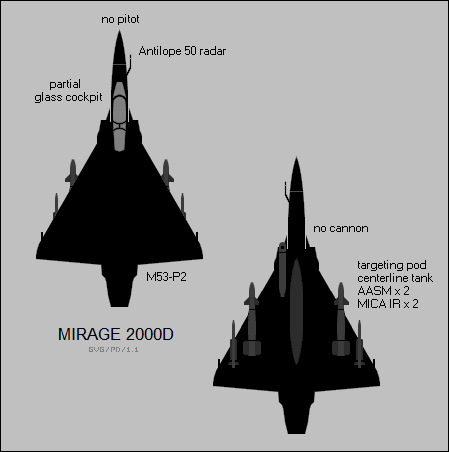
AA Mirage 2000Ds served in the intervention in Afghanistan from 2001, operating in close conjunction with international forces and performing precision attacks with LGBs. Two Mirage 2000Ds, along with two Mirage 2000Cs pressed into the strike role, were committed to operations in the Sahel region of Africa from 2014, operating out of Niamey in Niger and dropping LGBs. The Mirage 2000Cs had to use "buddy" laser target designation, provided by the 2000Ds.
BACK_TO_TOP* By the late 1980s, the Mirage 2000 was beginning to show its age relative to the competition, and export sales slumped. Dassault and Thomson-CSF began work on a privately-funded update of the Mirage 2000C to compete with the latest models of US F-16 fighters. The new "Mirage 2000-5" was to feature updated avionics and MICA missile armament. A two-seat Mirage 2000B prototype was extensively modified as the first Mirage 2000-5 prototype, first flying on 24 October 1990 with Patrick Experton at the controls. A Mirage 2000C prototype was then reworked to a similar standard, performing its initial flight on 27 April 1991.

As it emerged, the Mirage 2000-5 was difficult to distinguish from first-generation Mirage 2000 variants, and possessed the same SNECMA M53-P2 engine. The only really visible difference from a Mirage 2000C was that the Mirage 2000-5 lacked a nose pitot probe. However, the avionics system had been almost completely modernized, featuring:
The Mirage 2000-5 could also carry the oversized drop tanks developed for the Mirage 2000N, greatly extending range. A Mirage 2000-5 could carry four MICA EMs and two MICA IRs.
A two-seater "Mirage 2000-5D" version was developed as well. The back-seater had the HUD but not the associated head-level display, and as with first-generation two-seaters, there were no built-in cannon -- though cannon pods could be carried.
* Dassault needed an order from the AA to help promote foreign sales, and after some lobbying, in 1993 the AA decided to upgrade 37 of their existing Mirage 2000s to 2000-5 specification as a stopgap before the arrival of the Rafale. The upgraded aircraft were redesignated "Mirage 2000-5F", and became operational in 2000. They retained the old countermeasures system with the SERVAL / SABRE / Spirale units; they did not receive the ICMS 2 system. The aircraft upgraded were later production Mirage 2000Cs and their RDI radars were passed on to early Mirage 2000Cs with the old RDM radar. The AA is now considering further upgrades, including the MIDS datalink and the Thales Topsight helmet-mounted display / sighting system.
* That was not actually the first order for the Mirage 2000-5. In 1992, the Taiwanese Air Force ordered 48 "Mirage 2000-5EI" fighters and 12 "Mirage 2000-5DI" trainers, with introduction of the first squadron in 1997 and the last fighters delivered in 1999; the Taiwanese ordered a set of ASTAC ELINT pods for their Mirages. There have been rumors that the Taiwanese, in the face of difficulties in obtaining support from France, were going to phase out their Mirage 2000 fleet -- but at last notice, there were no plans to retire them, with Taiwan investigating a life extension of the fleet.
In 1994, Qatar ordered nine "Mirage 2000-5EDA" fighters and three "Mirage 2000-5DDA" trainers, with initial deliveries in late 1997.
BACK_TO_TOP* Dassault the extended the improvements of the Mirage 2000-5 a bit further with the "Mirage 2000-5 Mark 2", an enhanced, fully multi-role version of the Mirage 2000-5. The Mirage 2000-5 Mark 2 featured:
The cockpit was updated as well, with the same general layout but with larger color displays and other modernizations. The Thales Topsight helmet-mounted display / sighting system was offered as an option. The Mirage 2000-5 Mark 2 also included a datalink for the targeting of MICA ER missiles and could carry the Damocles targeting pod.
* Abu Dhabi / UAE was the launch customer, ordering 32 new-build aircraft, including 20 single-seaters as the "Mirage 2000-9" and 12 two-seaters as the "Mirage 2000-9D". These featured a classified countermeasures system designated "IMEWS", and comparable to ICMS 3. Initial deliveries of the UAE Mirages were in the spring of 2003. 30 of Abu Dhabi's older Mirage 2000s were also upgraded to Mirage 2000-9 capability.
The UAE Mirage 2000-9s were well-equipped for the strike mission, since they were provided along with the "Shehab" laser targeting pod, a variant of the Damocles, and the Nahar navigation pod, complementing the air-to-ground modes of the RDY-2 radar. The UAE also obtained the "Black Shahine" cruise missile, a variant of the APACHE. Abu Dhabi signed a contract to upgrade their Mirage 2000 fleet in 2019 -- though only as a stopgap, the plan being to replace them with the next-generation Dassault Rafale fighter.
* In 2000, Greece ordered a batch of 25 Mirage 2000-5 Mark 2 fighters. The order included 15 new-build aircraft and 10 upgrades from existing Greek Mirage 2000EGs, with aircraft featuring the SATURN secure radio. Apparently the Greek order did not include any upgrades of two-seaters. Greece is now retiring its Mirage 2000 fleet in favor of Rafales.

Dassault also competed for a Brazilian deal with the "Mirage 2000 BR", another variant of the Mirage 2000-5 Mark 2, with the French company partnering with Embraer of Brazil on the deal. Unfortunately, Brazilian budget problems led to continuous extensions of the competition, and in the spring of 2005 the Brazilians finally decided to buy a dozen refurbished AA Mirage 2000Cs. The first were delivered in September 2006, with the last of the batch delivered in 2008. They didn't stay in service long, the Brazilian Mirage 2000 fleet being withdrawn in 2013.
Another piece of Rafale technology that was ported to the Mirage 2000 was the Thales AIDA visual identification pod, which included infrared and optical sensors for IFF and targeting. It was put in service with AA Mirage 2000-5Fs. Further development of the second-generation type is expected to include a GPS receiver, MIDS datalink, and unspecified long-range sensors.
BACK_TO_TOP* The "Mirage 4000" was a scaled-up version of the Mirage 2000, initially powered by twin SNECMA M53-2 engines. It was originally announced in late 1975 as the "Delta Super Mirage", intended to compete with the US McDonnell-Douglas F-15 Eagle heavy fighter. A mockup was displayed two years later and first flight was on 9 March 1979, with Jean-Marie Saget at the controls. It appeared at the Paris Air Show later in the year. The aircraft was privately funded, with Dassault having an eye on Middle Eastern users, particularly the Saudis and the Iraqis. The company also thought it could be a good replacement for the AA's Mirage IV bomber.
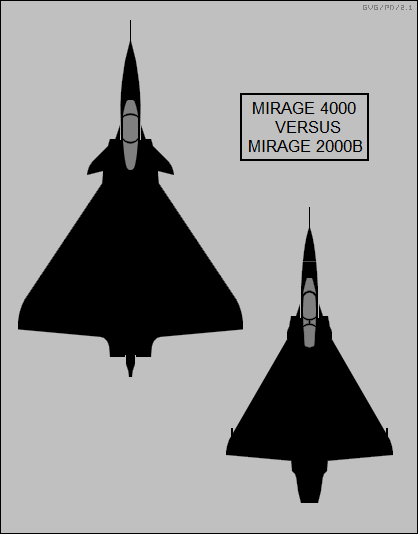
The Mirage 4000 leveraged off of Mirage 2000 technology, but had an empty weight 74% greater than that of the Mirage 2000. The Mirage 4000 was partly built of composite materials. It had an FBW AFCS and canards mounted on the air intakes. It was intended to be used as an interceptor and for low-level strike, with a warload of 8 tonnes (17,600 pounds) carried on 11 stores pylons. Extensive internal fuel tankage gave it long range. Like other Mirage delta fighters, it was fitted with twin 30-millimeter cannon. The cockpit layout was analog, though it did have a HUD; a Thomson-CSF Cyrano 500 radar, a more powerful derivative of the RDM fitted to the Mirage 2000, was considered but not fitted.
___________________________________________________________________
DASSAULT MIRAGE 4000:
___________________________________________________________________
wingspan:
12 meters (39 feet 4 inches)
wing area:
73 sq_meters (758.8 sq_feet)
length:
18.7 meters (61 feet 4 inches)
empty weight:
13,000 kilograms (28,660 pounds)
typical loaded weight:
17,000 kilograms (37,500 pounds)
maximum speed:
2,445 KPH (1,520 MPH / 1,320 KT)
service ceiling:
20,000 meters (65,600 feet)
combat radius:
2,000 KM (1,245 MI / 1,080 NMI)
___________________________________________________________________
Only one prototype was built, flying in tests and demonstrations during the early 1980s, during which it was updated to SNECMA M53-5 engines. The Saudis, having obtained F-15s, were not interested, and the Iraqis, strapped for cash due to their war with Iran, couldn't afford it. The AA was focused on buying Mirage 2000s. The prototype was finally grounded and parked in 1983 -- to be hastily refurbished in 1985, when the Saudis started talking about a buy. The prototype was repainted in spiffy desert camouflage colors and went through its paces for several years, but the Saudi deal kept dragging out and finally died. Dassault officials suspected that the Saudis had caved in to pressure from their American friends to drop the deal.
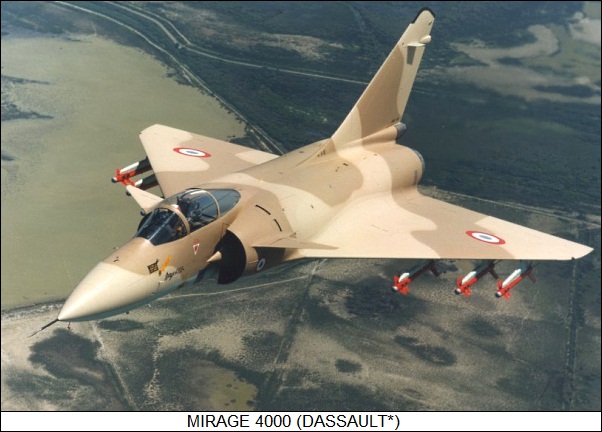
By that time, Dassault was focused on what would become the Rafale and the Mirage 4000 was old news. The prototype evaluated some technologies for the Rafale, finally performing its last flight on 8 January 1988. The aircraft remained parked until 1992, when it was passed on to the Musee de l'Air in Paris, to be refurbished again and put on display in 2002.
BACK_TO_TOP* A total of 601 Mirage 2000s was built in all. The list below outlines Mirage 2000 users and variants:
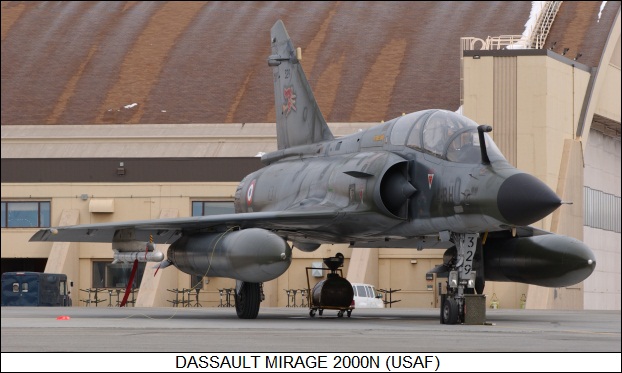
* Sources include:
* Revision history:
v1.0 / 01 mar 00 v1.0.1 / 01 aug 02 / Review & polish. v1.0.2 / 01 dec 02 / Added comments on Mirage 2000-9 customers. v2.0.0 / 01 dec 04 / Review & polish. v2.0.1 / 01 dec 06 / Review & polish. v2.0.2 / 01 may 07 / Review & polish. v2.0.3 / 01 apr 09 / Review & polish. v2.0.4 / 01 mar 11 / Review & polish. v2.0.5 / 01 feb 13 / ASTAC pod for Mirage 2000D. v2.0.6 / 01 jan 15 / India update. v2.0.7 / 01 dec 16 / Review & polish. v2.1.0 / 01 nov 18 / Mirage 2000N retirement. v2.1.1 / 01 sep 20 / Review & polish. v2.1.2 / 01 jul 22 / Review & polish. v2.1.3 / 01 jun 24 / Review & polish. (+)
This document originally began life as a part of an article on the entire Mirage delta series, including the Mirage III and its relatives, as well as the Mirage IV bomber. As I learned more details about these aircraft that arrangement proved too restrictive, and I broke it into three separate documents, the first on the Mirage III family, the second on the Mirage 2000 and 4000, and the third on the Mirage IV.
BACK_TO_TOP